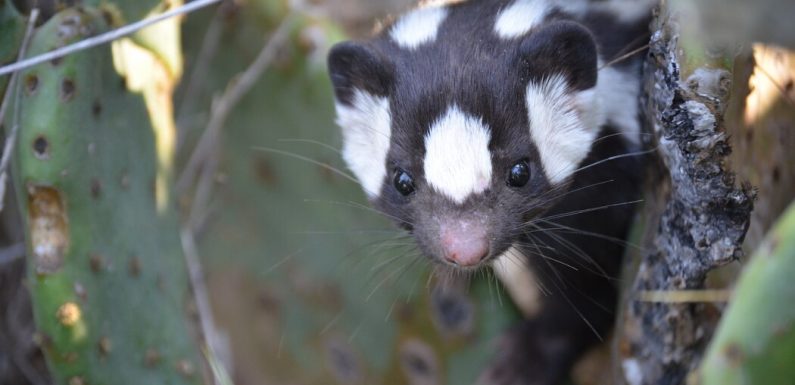
Black fur, white stripes, fanny full of foul-smelling liquid — everybody can identify the striped skunk. But did you know these malodorous mammals have a number of smaller cousins marked by a pattern of black-and-white Rorschach blots? They’re known as the spotted skunks, and they do something the stripeys can’t.
Spotted skunks perform a spread-eagled handstand before they spray you.
“I jokingly call them the acrobats of the skunk world,” said Adam Ferguson, a small carnivore biologist at the Field Museum in Chicago.
Now that you’ve met the spotted skunk, here’s another important fact: There are more than one species, and parsing the difference between them is tricky. For starters, the stink-butts all look rather similar. Most scientists these days agree that there are four spotted skunk species, though earlier research pointed to as few as two species or as many as 14.
However, researchers have a new answer to this question that they published Thursday in the journal Molecular Phylogenetics and Evolution. It’s based on more than 200 DNA samples collected from spotted skunks, some of which were roadkill, in places from British Columbia to Costa Rica.
“There are definitely seven species,” says Molly McDonough, a phylogenomicist at Chicago State University and a research associate at both the Field Museum and the Smithsonian’s Museum of Natural History.
Dr. McDonough and Dr. Ferguson, the colead authors of the new study, are also married. She calls him the skunk wrassler, and he calls her the lab wizard. When he proposed, he even slipped the ring into a box of DNA prep products.
It’s like they say, the couple that gets sprayed together, stays together.
“If you approach the skunk very quietly and gently, they tend not to spray,” Dr. Ferguson said. “But I say skunks are like people. Some of them are just jerks.”
Even though spotted skunks do all they can to keep researchers at a distance, there are several compelling reasons to study the pint-size carnivores.
For instance, now that researchers have mapped out seven distinct lineages according to genomic similarities, they can see that the spotted skunks have diversified much more than their close relatives, the striped skunks and hog-nosed skunks (which look a bit like a skunk version of a black and white cookie). This is curious, and the scientists suspect it has something to do with spotted skunks being the smallest of North America’s stinkers.
“We would kind of hypothesize that they’re more rodent-like,” Dr. Ferguson said, referring to the two-pound skunks’ inability to travel very far in any direction and their relatively quick breeding cycles.
These factors seem to have allowed the spotted skunks to branch into new species over the course of the last ice age and its alterations to North America’s climate.
The researchers also found that most of the spotted skunk species could be divided into two groups, or clades, three of which hailed from the east and three from the west. (The seventh spotted skunk species, Spilogale yucatanensis, is a bit of a weirdo, being native to Mexico’s Yucatán Peninsula but sharing the closest evolutionary relationship with S. putorius, which is native to Florida and the American Southeast.)
The greatest distinction between the two clades is that they seem to reproduce in entirely different ways. In the eastern clade, females tend to be pregnant for around 50 to 65 days, mating in March or April and giving birth in May or June. Out west, spotted skunks usually breed in the fall around September or October, and then give birth in April or May for a total gestation time of 180 to 200 days.
How is this possible? There’s evidence that the western skunks use a strategy known as delayed implantation, where a fertilized egg goes into a period of dormancy before development. Females from many mammal species, from bats to bears, use this practice to conserve resources and survive seasonal shortages of food.
And because representatives from both clades have overlapping territories in places like Texas, you could have two spotted skunks in the same place that appear identical but who apparently cannot breed with each other because their reproductive strategies are incompatible.
So, what’s it like to study skunks with your significant other? Well, once upon a time in Mexico, a hog-nosed skunk had just sprayed Dr. Ferguson in the face, rendering him temporarily blind.
“While I ran screaming for water, she actually asked me, ‘Do I help you or do I catch the skunk?’” he said.
Not wanting to lose the data point, Dr. McDonough caught the skunk.
Source: Read Full Article